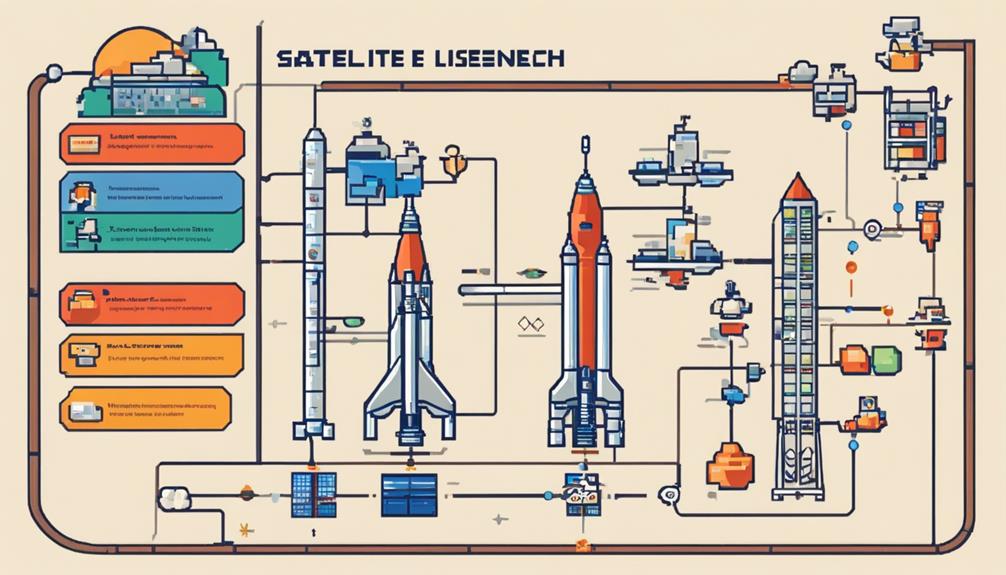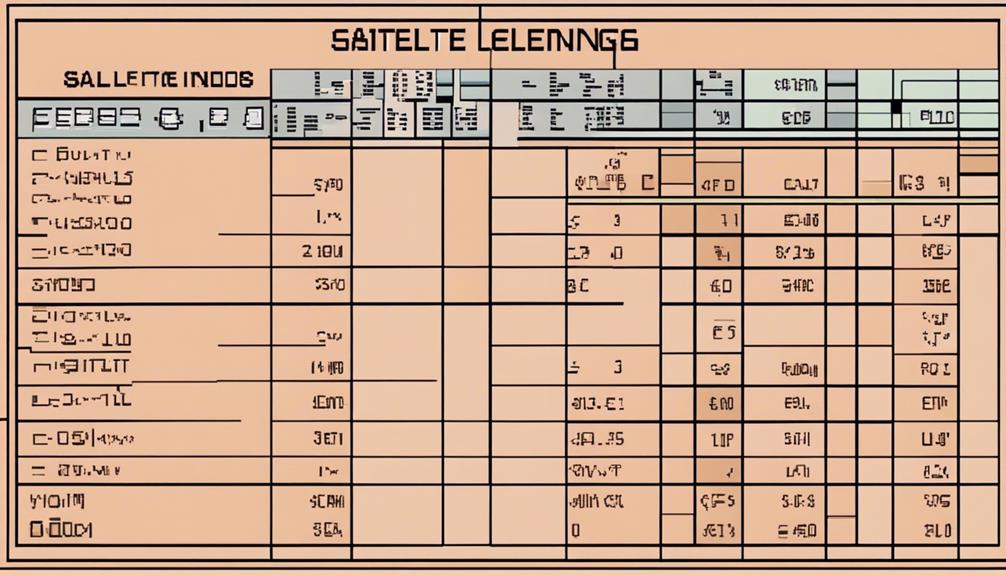The licensing procedures for satellite launches are critical in ensuring the safe and efficient deployment of satellites into orbit. From regulatory agencies overseeing the process to the specific criteria that applicants must meet, the journey from application to approval involves intricate steps and considerations. With the increasing number of small satellites being launched, the need for robust licensing procedures has become more pressing. Understanding the nuances of these procedures is essential for satellite operators and stakeholders to navigate the complexities of the licensing landscape successfully.
Key Takeaways
- Satellite licensing involves rigorous evaluation based on size, lifetime, and safety measures.
- Compliance with trackability and collision avoidance standards is crucial for licensing approval.
- Application process includes addressing debris mitigation, safety, and regulatory requirements.
- Financial obligations like surety bonds, regulatory fees, and milestones are part of the licensing process.
Regulatory Agencies Involved

The regulatory framework governing satellite launches in the United States involves several key governmental agencies responsible for overseeing licensing procedures. The Federal Communications Commission (FCC), National Oceanic and Atmospheric Administration (NOAA), and the Federal Aviation Administration (FAA) play pivotal roles in the licensing process for satellite launches.
The FAA Office of Commercial Space Transportation, a branch of the FAA, is primarily responsible for regulating and licensing commercial space activities, including satellite launches. Within the FAA, various types of licenses are issued to regulate different aspects of satellite launches. These licenses include launch licenses, re-entry licenses, and experimental permits.
Operator Licenses are a crucial component of the regulatory process, as they authorize specific launch and re-entry activities for satellites from designated sites. These licenses ensure that satellite operators adhere to strict safety and operational guidelines during the launch and re-entry phases. Additionally, Launch Site Licenses are granted by the FAA to oversee the operation of launch and re-entry facilities, ensuring that these sites meet all necessary safety and environmental requirements for conducting satellite launches.
Criteria for Licensing Approval
Considering the technical specifications and operational parameters of satellite missions plays a crucial role in determining licensing approval for satellite launches. Licensing approval for satellite launches involves a thorough evaluation of criteria such as satellite size, in-orbit lifetime, mass, and deployment altitude. Applicants seeking licensing must demonstrate their capability to assess and limit the generation of orbital debris during the satellite's mission to ensure responsible space operations. Additionally, trackability of satellites in orbit is a key factor in licensing approval, as it is essential for collision avoidance and maintaining space situational awareness.
Moreover, licensing authorities closely examine and mitigate casualty risks associated with small satellite operations. This assessment is crucial to safeguard space assets and prevent harm to other satellites or spacecraft. Compliance with specific criteria related to spacecraft size, trackability, and casualty risk is paramount for streamlined licensing approval for satellite launches. By adhering to these stringent guidelines, satellite operators can contribute to the sustainability of space activities and enhance overall safety in orbit. Therefore, meeting the necessary criteria is fundamental in obtaining licensing approval for satellite launches.
Application Process Overview

To proceed with the licensing process for satellite launches, applicants must navigate a comprehensive application process overseen by regulatory bodies such as the FCC and FAA, ensuring strict adherence to safety, security, and international obligations. One crucial aspect of this process is the classification of satellites under Part 25 satellite licensing, distinguishing between large and small satellite licenses. Additionally, applicants may need to engage with the FCC's Experimental Radio processing round to secure necessary authorizations. License and Market Access depend on meeting specific Qualifying Characteristics outlined by these regulatory bodies.
Moreover, applicants must address concerns related to Debris and Collision mitigation strategies, particularly crucial during atmospheric re-entry. Licensees must demonstrate a comprehensive plan for managing space debris and minimizing collision risks to ensure the sustainability and safety of space activities. Furthermore, compliance with regulations surrounding Experimental Radio is essential for applicants seeking authorization for innovative satellite technologies.
Interference Protection Considerations
In the realm of satellite launch licensing procedures, paramount attention is devoted to ensuring interference protection considerations. Satellite operators are required to demonstrate the capability to eliminate harmful interference with other satellite systems to guarantee responsible satellite operations. This involves assessing and limiting the probability of generating debris to protect the space environment, thus emphasizing the importance of compliance with regulations on trackability standards and casualty risk assessment.
Specific criteria for trackability and casualty risk assessment play a crucial role in ensuring streamlined licensing procedures for satellite systems. By adhering to these standards, satellite operators can contribute to interference protection, which is essential for safe and efficient satellite operations in orbit. Responsible satellite operations require a meticulous approach to interference protection, encompassing measures to prevent disruptions to other satellites and minimize the risk of collisions or space debris creation.
Fee Structure and Financial Requirements

The financial obligations associated with satellite launch licensing procedures encompass a structured fee system and specific financial requirements that satellite operators must adhere to for regulatory compliance. For space station licenses, the costs range from $2,425 to $16,795 per Call Sign. Additionally, licensees are required to post surety bonds within 30 days of grant, with amounts varying from $1 million to $5 million. Annual regulatory fees are also part of the financial requirements for maintaining operational licenses. During the licensing process, fees may apply for license amendments, modifications, assignments, or transfer of control. Bonds can be released upon meeting specific satellite implementation milestones, providing an incentive for timely progress. It is essential for satellite operators to be aware of these financial aspects to ensure compliance with regulations. Moreover, the FCC Experimental License may involve additional financial considerations that operators need to address when pursuing experimental activities within the designated spectrum. Understanding and fulfilling these financial requirements are crucial steps in the satellite launch licensing process to facilitate smooth operations and regulatory adherence.
Frequently Asked Questions
Do You Need Permission to Launch a Satellite?
Legal requirements and international agreements stipulate that government permissions are necessary to launch a satellite. Launch authorizations are granted based on regulatory compliance with space treaties and satellite regulations. Operators must adhere to launch restrictions and undergo a licensing process to obtain launch permits. This process involves demonstrating compliance with safety, security, and financial responsibility obligations, as well as securing liability insurance coverage. Thorough documentation and legal advice may be required during the application process.
What Regulatory Approvals Are Needed to Launch a Satellite in Space?
In order to launch a satellite into space, regulatory approvals are required to ensure compliance with international treaties, safety standards, environmental impact assessments, frequency coordination, national security protocols, liability insurance obligations, launch location considerations, orbital debris mitigation plans, spectrum allocation regulations, and export control laws. These measures are essential to safeguard space activities, prevent conflicts, and promote responsible space exploration and utilization.
Do I Need a License to Launch a Rocket?
In the realm of rocket safety and launch regulations, the complexities of space exploration necessitate meticulous adherence to launch requirements and space policy. To engage in rocket launches, understanding the intricacies of rocket technology, launch logistics, space law, and rocket propulsion is paramount. Delving into the world of satellite communication, one must recognize the critical role of obtaining the appropriate licenses to ensure compliance with regulatory bodies and international obligations.
What Is a Satellite License?
A satellite license is a regulatory approval required for the operation of satellites in space. It encompasses compliance with satellite regulations, licensing requirements, orbital permits, and launch authorization. This legal document outlines key details such as satellite technology, communication frequencies, and disposal plans. Satellite licenses are crucial in ensuring a responsible and organized approach to space exploration, promoting space policy adherence, mitigating space debris, and preventing interference within the space industry.
